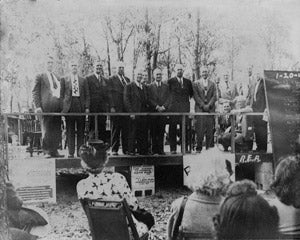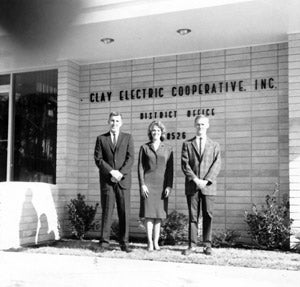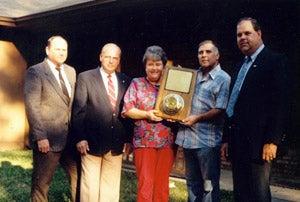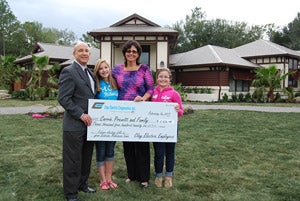Clay Electric had its beginnings as early as 1924. Ed Wiggins, a short, wiry, energetic pioneer type of about 40 moved from Green Cove Springs, Florida, to the sparsely populated shores of beautiful Lake Geneva to help with the difficult job of establishing the town of Keystone Heights.
Wiggins was employed by the Lawrence Development Company to construct, operate and maintain a power plant and distribution lines to serve electricity to this new community. Eventually, Wiggins purchased the plant and distribution lines and continued to run them for a number of years.
By about 1936, Wiggins’s power plant had grown to 115 kilowatts (kW) and his distribution system, which was operated at primary voltage of 2,400 and stepped down to a voltage of 120/240, had grown to 100 miles of lines. His lines extended southeast to Florahome and south to Lake Swan and Lake Rosa. As the area grew, Wiggins needed capital for systems improvements and for extension of his lines into adjacent rural areas. Wiggins learned of a program offered by the federal government under the Emergency Relief Appropriations Act. He wrote to the Rural Electrification Administration (REA) and requested information. After intensive research and study, it appeared that Wiggins would be able to get his loan approved, but he was concerned about running a system as large as the REA required. Meetings began to take place and work was done on the organization of a rural electric cooperative. Customers were first signed up in rural areas of Clay, Alachua, Putnam, Columbia, Union and Marion counties.
Wiggins gathered the lists of signed customers and maps he had made and went to Washington to see the REA.
On December 9, 1937, the Clay Electric Cooperative Association was incorporated and received its charter from the State of Florida. The first meeting of the Cooperative was held at the Keystone Inn at 2 p.m. on December 21, 1937.
The first district office, the Meadowbrook office, was opened in 1964 and proved its value to management in the belief that the time had come for the cooperative to decentralize so it could better serve customers in outlying areas. Later, when the district moved to its existing location, its name was changed to Orange Park West.
The Gainesville District Office was constructed in 1965 and represented the second district to be put in operation. Four other district offices were established by 1973, so that every area served by the Cooperative is served by a district office. The other districts are Keystone Heights, Palatka, Salt Springs and Lake City.
Seminole Electric Cooperative’s generating plant near Palatka began commercial operation in 1984, supplying Clay Electric with power that previously was purchased from private investor-owned utilities and lessening its dependence on foreign oil.
The co-op welcomed its 100,000th member in 1990, becoming the third electric co-op in the nation to reach this milestone. Clay Electric and the Jacksonville Electric Authority reached a territorial agreement in 1993 that transferred Clay County accounts to the co-op and Duval County accounts to the JEA.
The co-op has handled major weather situations like Hurricane Dora in 1964; bitter cold at Christmas 1989, when power demand reached 478 megawatts; the “Storm of the Century” in 1993, which lashed the co-op’s distribution lines; and the two major hurricanes in 2004 that cost a combined $10-12 million in repairs. After the 2004 hurricanes, significant changes were made to the Emergency Operations Plan to include a thorough damage assessment procedure. In the past decade, major hurricanes like Hurricane Irma (2017), Hurricane Helene (2024) and others have caused millions of dollars in damage to the co-op’s system.
The co-op has embraced technology throughout the years to improve member services. Computers were installed as early as 1966, with remote terminals being placed in 1977. A remote meter reading program was offered to members in 1994 as a convenience for members. In 1996, the co-op launched its first website. In 2012, Clay Electric implemented a GPS mapping system of its entire service area; the system was then converted to an advanced metering infrastructure by 2020.
In 2021, the co-op made significant improvements to its computer-based systems by partnering with the National Information Solutions Cooperative (NISC). The outage, financial, customer information and other systems were integrated into one platform, making the creation of the MyClayElectric mobile app possible and elevating the member experience by offering credit card payments, daily usage data and alerts, outage communication and more.
Concern for Community is one of the seven Cooperative Principles, and Clay Electric has always participated in community events and programs. In 2011, the co-op participated in the television program “Extreme Makeover: Home Edition,” when a member family in Middleburg was selected to receive a new home. The cooperative launched the Operation Round Up program (in which members voluntarily round up their electric bills to the nearest dollar and donate the proceeds) in late 2016, and since then has disbursed millions of dollars to community organizations through the Clay Electric Foundation.
Clay Electric has had six general managers during its existence: A.G. ”Pat” Loudon, 1940-1962; E.T. Martin, 1962-1983; Tommy Millican, 1983-1989; Bill Phillips, 1989-2009; Ricky Davis, 2009-2026; and Andy Chaff, 2026-present.




